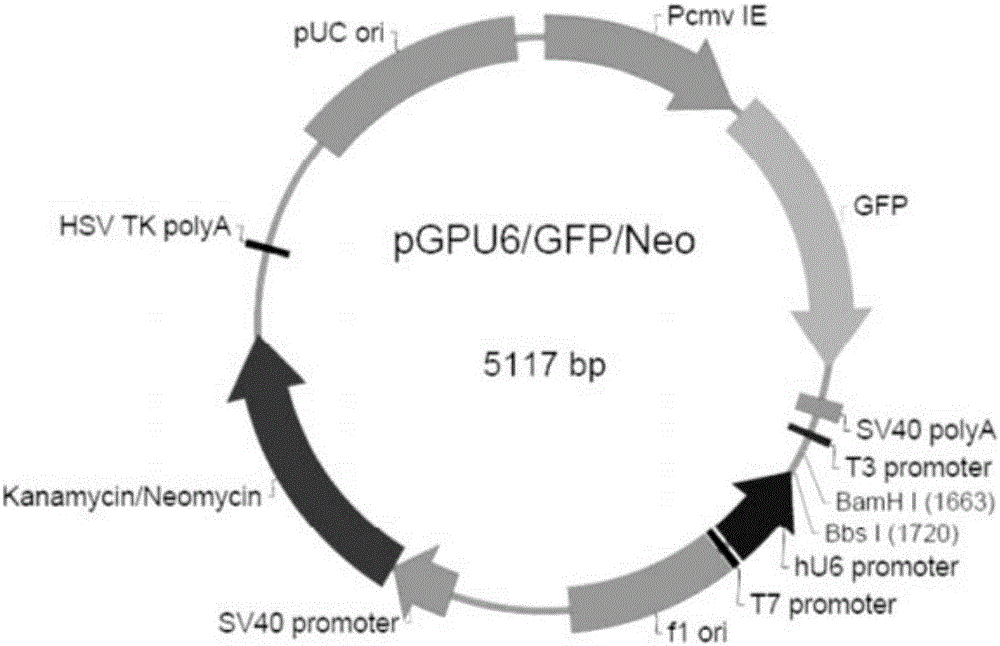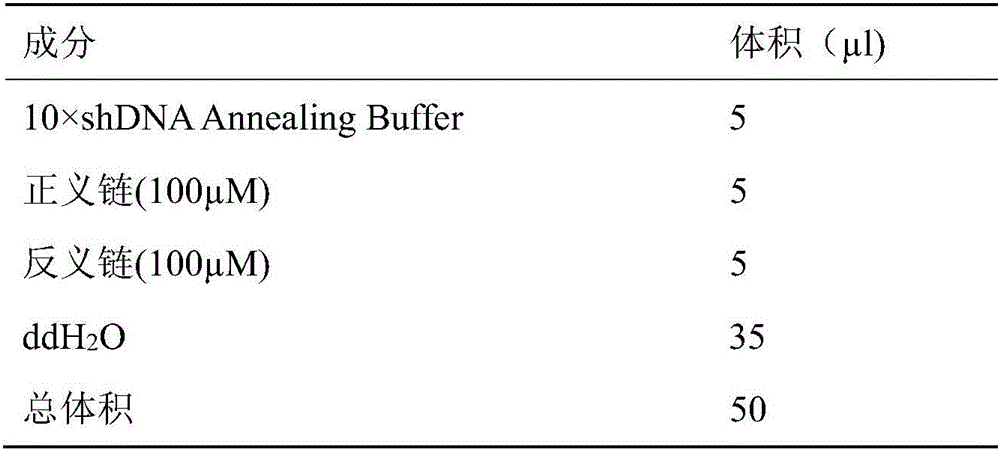SiRNA for regulating expression of integrase and drug-resistant gene cassette and application thereof
A drug-resistant gene, integrase technology, applied in DNA/RNA fragments, gene therapy, genetic engineering, etc., can solve problems such as gene-specific silencing
- Summary
- Abstract
- Description
- Claims
- Application Information
AI Technical Summary
Problems solved by technology
Method used
Image
Examples
Embodiment 1
[0027] Embodiment 1, siRNA
[0028] Through a large number of experimental studies and screenings in the early stage, the present invention finally found that two kinds of siRNAs have good effects on the capture of drug-resistant gene cassettes and the expression of drug-resistant genes by integrase genes in silencing and interfering bacterial integrin systems (high efficiency and specificity) ), the specific sequences of these two siRNAs are as follows.
[0029] siRNA-I:
[0030] siRNA-1 sense strand: 5'-GCUGAAAGGUCUGGUCAUATT-3' (SEQ ID NO: 1),
[0031] siRNA-1 antisense strand: 5'-UAUGACCAGACCUUUCAGCTT-3' (SEQ ID NO: 2),
[0032] siRNA-II:
[0033] siRNA-II sense strand: 5'-CCCGUUCCAUACAGAAGCUTT-3' (SEQ ID NO: 3),
[0034] siRNA-II antisense strand: 5'-AGCUUCUGUAUGGAACGGGTT-3' (SEQ ID NO: 4).
[0035]The synthesis of the above siRNA can be directly synthesized by chemical method (can be synthesized by the corresponding biological company). The following methods are ado...
Embodiment 2
[0036] The construction of embodiment 2 siRNA interference carrier
[0037] 1) siRNA annealing
[0038] Dissolve the synthesized siRNA sense strand and antisense strand in TE into a solution with a concentration of 100 μM, and prepare an annealing reaction system according to the following table.
[0039]
[0040] Place the above annealing reaction system on a PCR instrument for annealing treatment: 95°C, 5min; 85°C, 5min; 75°C, 5min; 70°C, 5min; store at 4°C to obtain shRNA fragments.
[0041] 2) Construction of pGPU6 / GFP / Neo-siRNA expression vector
[0042] The vector map of pGPU6 / GFP / Neo (purchased from Shanghai Jima Pharmaceutical Technology Co., Ltd.) is as follows figure 1 As shown, the pGPU6 / GFP / Neo vector was digested with BbsI and BamHI to obtain the target linear fragment, and then the shRNA fragment obtained above was ligated with the digested pGPU6 / GFP / Neo. The ligation system was as follows:
[0043]
[0044]
[0045] After reacting at 22°C for 1 hour,...
Embodiment 3
[0046] The detection of embodiment 3 siRNA interference efficiency
[0047] experimental method:
[0048] In order to detect the interference efficiency of the siRNA of the present invention, the siRNA-I and siRNA-II interference vectors prepared in Example 2 were transfected into drug-resistant bacteria Escherichia coli E.coli BL21 (DE3), and the drug-resistant E. coli contained the integrated The enzyme is IntI1, and the drug resistance gene cassette contained is aadA1. The transfection method is as follows: adding siRNA three times, adding once every 2 hours, the final concentration of the co-cultivation system is 0.2 μM siRNA, and the co-cultivation time is 8 hours. RT-PCR quantitatively detected the mRNA expression levels of the target genes (integrase IntI1, drug-resistant gene box aadA1) in the drug-resistant Escherichia coli E. coli BL21 (DE3) before and after siRNA treatment; control group.
[0049] The above RT-PCR system and program are:
[0050] Use Bio-Bad CFX...
PUM
 Login to View More
Login to View More Abstract
Description
Claims
Application Information
 Login to View More
Login to View More - R&D Engineer
- R&D Manager
- IP Professional
- Industry Leading Data Capabilities
- Powerful AI technology
- Patent DNA Extraction
Browse by: Latest US Patents, China's latest patents, Technical Efficacy Thesaurus, Application Domain, Technology Topic, Popular Technical Reports.
© 2024 PatSnap. All rights reserved.Legal|Privacy policy|Modern Slavery Act Transparency Statement|Sitemap|About US| Contact US: help@patsnap.com










